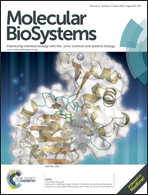Molecular dynamics simulations and statistical coupling analysis of GPI12 in L. major: functional co-evolution and conservedness reveals potential drug–target sites†
Abstract
GPI12 represents an important enzyme in the GPI biosynthetic pathway of several parasites like ‘Leishmania’. GPI activity is generally regulated through either the hindrance in GPI complex assembly formation or the modulation of the lipophosphoglycan (LPG) flux to either reduce or enhance the pathogenicity in an organism. Of the various GPI molecules known, GPI12 is an important enzyme in the GPI biosynthetic pathway which can be exploited as a target due to the substrate specificity difference in parasites and humans. In the present study, the functional importance of the co-evolving residues of the GPI12 protein of Leishmania has been highlighted using the GPI proteins belonging to the GlcNAC-deacetylase family. Exploring the active site of the GPI12 protein and designing inhibitors against the functional residues provide ways and means to change the efficiency of deacetylation activity of the enzyme. The activity of de-N-acetylase is low in the absence of metal ions like zinc. Hence we designed eight small molecules in order to modulate the activity of GPI12. Compound 8 was found to be an appropriate choice to target the agonist (GPI12) active site thereby targeting the residues which were essential in the Zn binding and chelation activity. Inhibition of these sites offered a strong constraint to block the protein activity and in turn GPI biosynthesis.


 Please wait while we load your content...
Please wait while we load your content...